Friedemann Zenke
Decoding finger velocity from cortical spike trains with recurrent spiking neural networks
Sep 03, 2024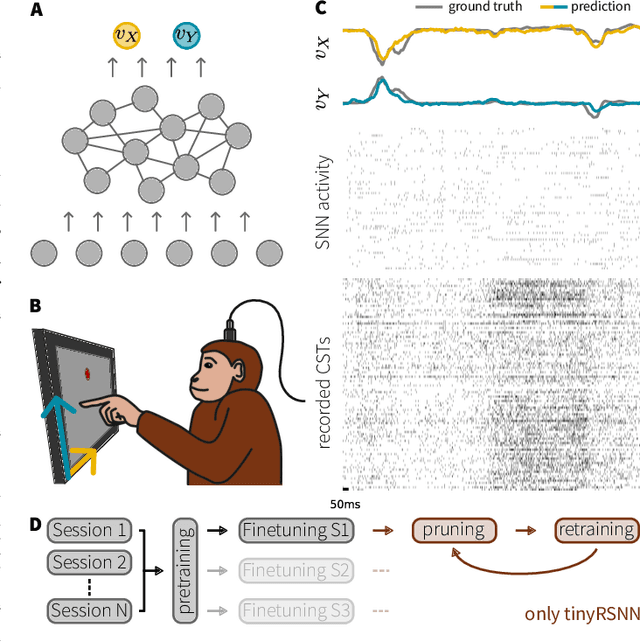
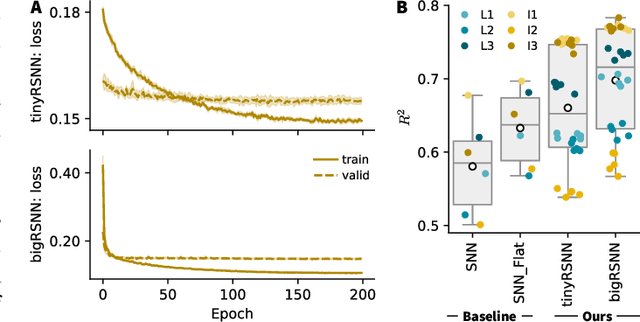
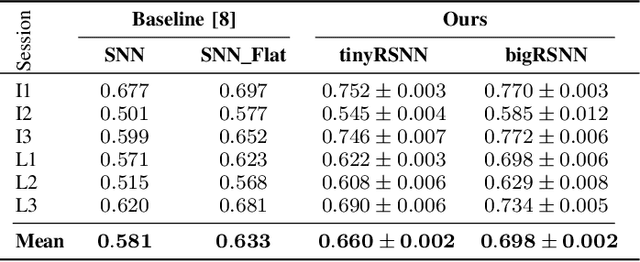
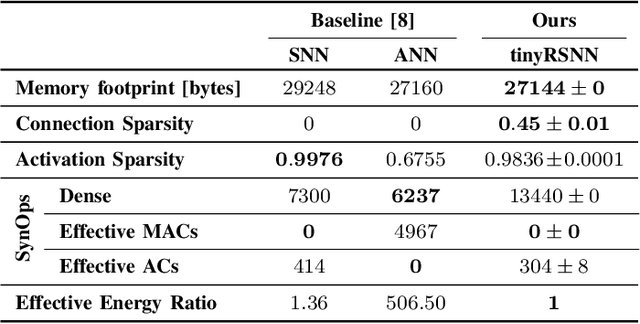
Abstract:Invasive cortical brain-machine interfaces (BMIs) can significantly improve the life quality of motor-impaired patients. Nonetheless, externally mounted pedestals pose an infection risk, which calls for fully implanted systems. Such systems, however, must meet strict latency and energy constraints while providing reliable decoding performance. While recurrent spiking neural networks (RSNNs) are ideally suited for ultra-low-power, low-latency processing on neuromorphic hardware, it is unclear whether they meet the above requirements. To address this question, we trained RSNNs to decode finger velocity from cortical spike trains (CSTs) of two macaque monkeys. First, we found that a large RSNN model outperformed existing feedforward spiking neural networks (SNNs) and artificial neural networks (ANNs) in terms of their decoding accuracy. We next developed a tiny RSNN with a smaller memory footprint, low firing rates, and sparse connectivity. Despite its reduced computational requirements, the resulting model performed substantially better than existing SNN and ANN decoders. Our results thus demonstrate that RSNNs offer competitive CST decoding performance under tight resource constraints and are promising candidates for fully implanted ultra-low-power BMIs with the potential to revolutionize patient care.
Resource-Efficient Speech Quality Prediction through Quantization Aware Training and Binary Activation Maps
Jul 05, 2024Abstract:As speech processing systems in mobile and edge devices become more commonplace, the demand for unintrusive speech quality monitoring increases. Deep learning methods provide high-quality estimates of objective and subjective speech quality metrics. However, their significant computational requirements are often prohibitive on resource-constrained devices. To address this issue, we investigated binary activation maps (BAMs) for speech quality prediction on a convolutional architecture based on DNSMOS. We show that the binary activation model with quantization aware training matches the predictive performance of the baseline model. It further allows using other compression techniques. Combined with 8-bit weight quantization, our approach results in a 25-fold memory reduction during inference, while replacing almost all dot products with summations. Our findings show a path toward substantial resource savings by supporting mixed-precision binary multiplication in hard- and software.
Theories of synaptic memory consolidation and intelligent plasticity for continual learning
May 27, 2024Abstract:Humans and animals learn throughout life. Such continual learning is crucial for intelligence. In this chapter, we examine the pivotal role plasticity mechanisms with complex internal synaptic dynamics could play in enabling this ability in neural networks. By surveying theoretical research, we highlight two fundamental enablers for continual learning. First, synaptic plasticity mechanisms must maintain and evolve an internal state over several behaviorally relevant timescales. Second, plasticity algorithms must leverage the internal state to intelligently regulate plasticity at individual synapses to facilitate the seamless integration of new memories while avoiding detrimental interference with existing ones. Our chapter covers successful applications of these principles to deep neural networks and underscores the significance of synaptic metaplasticity in sustaining continual learning capabilities. Finally, we outline avenues for further research to understand the brain's superb continual learning abilities and harness similar mechanisms for artificial intelligence systems.
Elucidating the theoretical underpinnings of surrogate gradient learning in spiking neural networks
Apr 23, 2024Abstract:Training spiking neural networks to approximate complex functions is essential for studying information processing in the brain and neuromorphic computing. Yet, the binary nature of spikes constitutes a challenge for direct gradient-based training. To sidestep this problem, surrogate gradients have proven empirically successful, but their theoretical foundation remains elusive. Here, we investigate the relation of surrogate gradients to two theoretically well-founded approaches. On the one hand, we consider smoothed probabilistic models, which, due to lack of support for automatic differentiation, are impractical for training deep spiking neural networks, yet provide gradients equivalent to surrogate gradients in single neurons. On the other hand, we examine stochastic automatic differentiation, which is compatible with discrete randomness but has never been applied to spiking neural network training. We find that the latter provides the missing theoretical basis for surrogate gradients in stochastic spiking neural networks. We further show that surrogate gradients in deterministic networks correspond to a particular asymptotic case and numerically confirm the effectiveness of surrogate gradients in stochastic multi-layer spiking neural networks. Finally, we illustrate that surrogate gradients are not conservative fields and, thus, not gradients of a surrogate loss. Our work provides the missing theoretical foundation for surrogate gradients and an analytically well-founded solution for end-to-end training of stochastic spiking neural networks.
Dis-inhibitory neuronal circuits can control the sign of synaptic plasticity
Oct 30, 2023

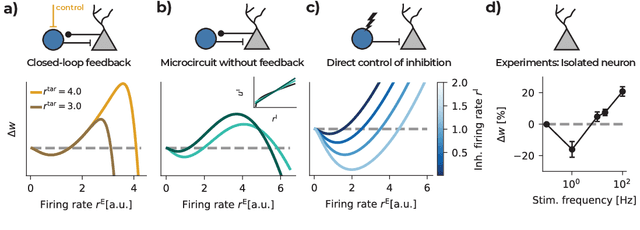

Abstract:How neuronal circuits achieve credit assignment remains a central unsolved question in systems neuroscience. Various studies have suggested plausible solutions for back-propagating error signals through multi-layer networks. These purely functionally motivated models assume distinct neuronal compartments to represent local error signals that determine the sign of synaptic plasticity. However, this explicit error modulation is inconsistent with phenomenological plasticity models in which the sign depends primarily on postsynaptic activity. Here we show how a plausible microcircuit model and Hebbian learning rule derived within an adaptive control theory framework can resolve this discrepancy. Assuming errors are encoded in top-down dis-inhibitory synaptic afferents, we show that error-modulated learning emerges naturally at the circuit level when recurrent inhibition explicitly influences Hebbian plasticity. The same learning rule accounts for experimentally observed plasticity in the absence of inhibition and performs comparably to back-propagation of error (BP) on several non-linearly separable benchmarks. Our findings bridge the gap between functional and experimentally observed plasticity rules and make concrete predictions on inhibitory modulation of excitatory plasticity.
Improving equilibrium propagation without weight symmetry through Jacobian homeostasis
Sep 05, 2023Abstract:Equilibrium propagation (EP) is a compelling alternative to the backpropagation of error algorithm (BP) for computing gradients of neural networks on biological or analog neuromorphic substrates. Still, the algorithm requires weight symmetry and infinitesimal equilibrium perturbations, i.e., nudges, to estimate unbiased gradients efficiently. Both requirements are challenging to implement in physical systems. Yet, whether and how weight asymmetry affects its applicability is unknown because, in practice, it may be masked by biases introduced through the finite nudge. To address this question, we study generalized EP, which can be formulated without weight symmetry, and analytically isolate the two sources of bias. For complex-differentiable non-symmetric networks, we show that the finite nudge does not pose a problem, as exact derivatives can still be estimated via a Cauchy integral. In contrast, weight asymmetry introduces bias resulting in low task performance due to poor alignment of EP's neuronal error vectors compared to BP. To mitigate this issue, we present a new homeostatic objective that directly penalizes functional asymmetries of the Jacobian at the network's fixed point. This homeostatic objective dramatically improves the network's ability to solve complex tasks such as ImageNet 32x32. Our results lay the theoretical groundwork for studying and mitigating the adverse effects of imperfections of physical networks on learning algorithms that rely on the substrate's relaxation dynamics.
Predictor networks and stop-grads provide implicit variance regularization in BYOL/SimSiam
Dec 09, 2022Abstract:Self-supervised learning (SSL) learns useful representations from unlabelled data by training networks to be invariant to pairs of augmented versions of the same input. Non-contrastive methods avoid collapse either by directly regularizing the covariance matrix of network outputs or through asymmetric loss architectures, two seemingly unrelated approaches. Here, by building on DirectPred, we lay out a theoretical framework that reconciles these two views. We derive analytical expressions for the representational learning dynamics in linear networks. By expressing them in the eigenspace of the embedding covariance matrix, where the solutions decouple, we reveal the mechanism and conditions that provide implicit variance regularization. These insights allow us to formulate a new isotropic loss function that equalizes eigenvalue contribution and renders learning more robust. Finally, we show empirically that our findings translate to nonlinear networks trained on CIFAR-10 and STL-10.
Fluctuation-driven initialization for spiking neural network training
Jun 21, 2022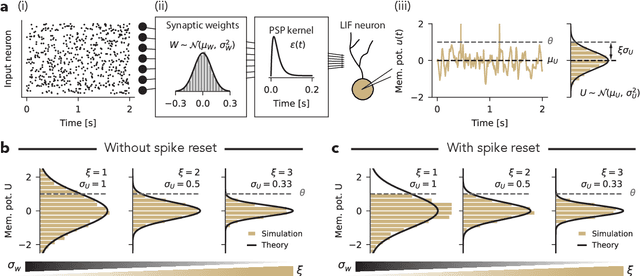

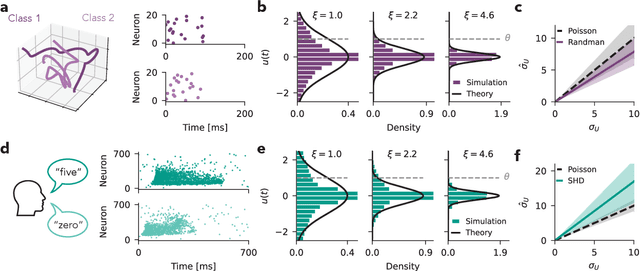

Abstract:Spiking neural networks (SNNs) underlie low-power, fault-tolerant information processing in the brain and could constitute a power-efficient alternative to conventional deep neural networks when implemented on suitable neuromorphic hardware accelerators. However, instantiating SNNs that solve complex computational tasks in-silico remains a significant challenge. Surrogate gradient (SG) techniques have emerged as a standard solution for training SNNs end-to-end. Still, their success depends on synaptic weight initialization, similar to conventional artificial neural networks (ANNs). Yet, unlike in the case of ANNs, it remains elusive what constitutes a good initial state for an SNN. Here, we develop a general initialization strategy for SNNs inspired by the fluctuation-driven regime commonly observed in the brain. Specifically, we derive practical solutions for data-dependent weight initialization that ensure fluctuation-driven firing in the widely used leaky integrate-and-fire (LIF) neurons. We empirically show that SNNs initialized following our strategy exhibit superior learning performance when trained with SGs. These findings generalize across several datasets and SNN architectures, including fully connected, deep convolutional, recurrent, and more biologically plausible SNNs obeying Dale's law. Thus fluctuation-driven initialization provides a practical, versatile, and easy-to-implement strategy for improving SNN training performance on diverse tasks in neuromorphic engineering and computational neuroscience.
Braille Letter Reading: A Benchmark for Spatio-Temporal Pattern Recognition on Neuromorphic Hardware
May 30, 2022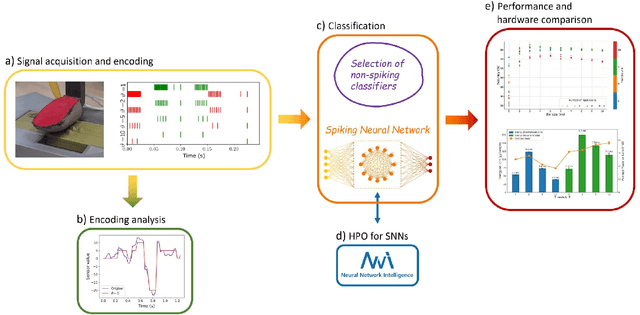
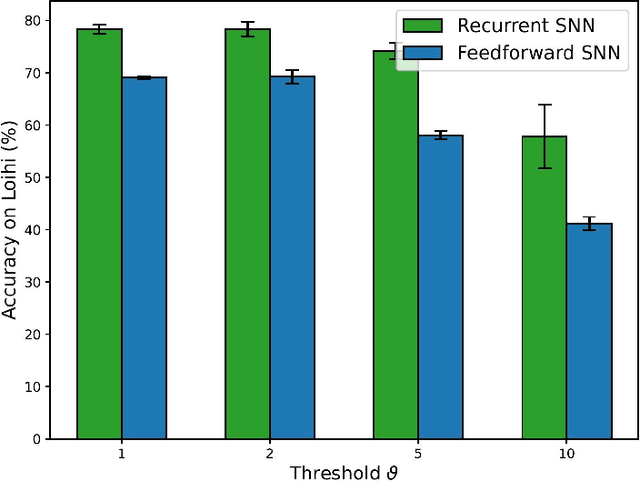
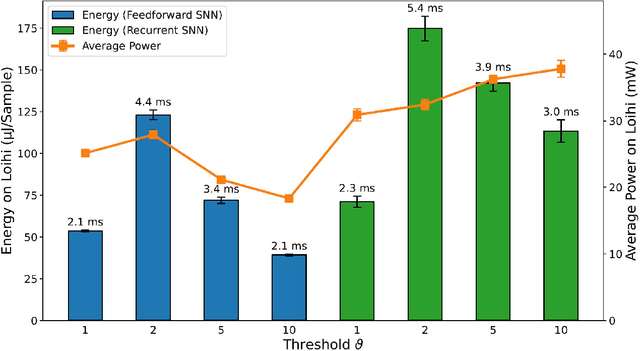

Abstract:Spatio-temporal pattern recognition is a fundamental ability of the brain which is required for numerous real-world applications. Recent deep learning approaches have reached outstanding accuracy in such tasks, but their implementation on conventional embedded solutions is still very computationally and energy expensive. Tactile sensing in robotic applications is a representative example where real-time processing and energy-efficiency are required. Following a brain-inspired computing approach, we propose a new benchmark for spatio-temporal tactile pattern recognition at the edge through braille letters reading. We recorded a new braille letters dataset based on the capacitive tactile sensors/fingertip of the iCub robot, then we investigated the importance of temporal information and the impact of event-based encoding for spike-based/event-based computation. Afterwards, we trained and compared feed-forward and recurrent spiking neural networks (SNNs) offline using back-propagation through time with surrogate gradients, then we deployed them on the Intel Loihi neuromorphic chip for fast and efficient inference. We confronted our approach to standard classifiers, in particular to a Long Short-Term Memory (LSTM) deployed on the embedded Nvidia Jetson GPU in terms of classification accuracy, power/energy consumption and computational delay. Our results show that the LSTM outperforms the recurrent SNN in terms of accuracy by 14%. However, the recurrent SNN on Loihi is 237 times more energy-efficient than the LSTM on Jetson, requiring an average power of only 31mW. This work proposes a new benchmark for tactile sensing and highlights the challenges and opportunities of event-based encoding, neuromorphic hardware and spike-based computing for spatio-temporal pattern recognition at the edge.
Brain-Inspired Learning on Neuromorphic Substrates
Oct 22, 2020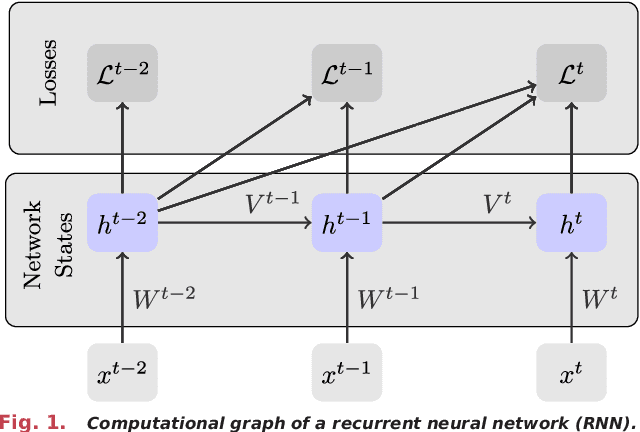
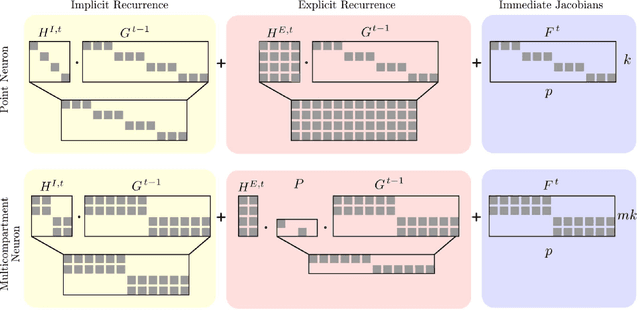


Abstract:Neuromorphic hardware strives to emulate brain-like neural networks and thus holds the promise for scalable, low-power information processing on temporal data streams. Yet, to solve real-world problems, these networks need to be trained. However, training on neuromorphic substrates creates significant challenges due to the offline character and the required non-local computations of gradient-based learning algorithms. This article provides a mathematical framework for the design of practical online learning algorithms for neuromorphic substrates. Specifically, we show a direct connection between Real-Time Recurrent Learning (RTRL), an online algorithm for computing gradients in conventional Recurrent Neural Networks (RNNs), and biologically plausible learning rules for training Spiking Neural Networks (SNNs). Further, we motivate a sparse approximation based on block-diagonal Jacobians, which reduces the algorithm's computational complexity, diminishes the non-local information requirements, and empirically leads to good learning performance, thereby improving its applicability to neuromorphic substrates. In summary, our framework bridges the gap between synaptic plasticity and gradient-based approaches from deep learning and lays the foundations for powerful information processing on future neuromorphic hardware systems.
 Add to Chrome
Add to Chrome Add to Firefox
Add to Firefox Add to Edge
Add to Edge